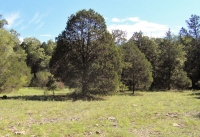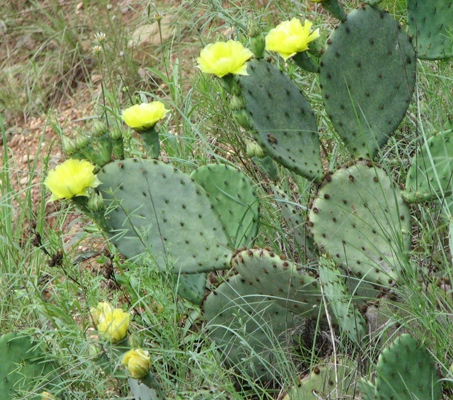Unlike the oaks and pines of other savannas, which have various adaptations for surviving and thriving after wildfires, red cedars are extremely sensitive to fire. Consequently, true cedar glades in Wisconsin only occur on cliffs, or north facing slopes that are never (or very rarely) touched by fire. Today many of the cedar glades in Wisconsin are found in the central and southwest regions of the state. While some of these glades are found on bedrock, many have actually developed on what were once dry prairies that were colonized by red cedar trees after fire suppression. Unlike bedrock based cedar glades, which remain tree-sparse for as long as it takes for soil to form on the bedrock (thousands of years or indefinitely), cedar glades on former dry prairies eventually progress to form dense cedar thickets where sun loving species are shaded out. These former-dry-prairie cedar glades are on dry sandy/gravelly, south or west facing slopes that would have burned in the past. In addition to 'eastern red cedar glades,' 'northern white cedar glades' occur on exposed bedrock in the northeast of the state. Here northern white cedar (Thuja occidentalis) replaces eastern red cedar. Northern white cedar, like eastern red cedar, is not a true cedar although it is a member of the cedar family.
Cedar glades don't form on just any type of bedrock. Dolomite (limestone), quartzite, rhyolite, and dry sandstone are the preferred substrates. Many of the plants found in cedar glades are called calciphiles (lovers of calcium) because they grow on calcareous (calcium rich) soil. It may not be the case that calciphiles love calcareous soils, but they have adaptated to tolerate high calcium, and low iron and phosphorus levels. Many calciphiles will grow in other soil types but are most competitive in calcareous soil. Plants found in cedar glades are also extremely well adapted to drought.
While cedars are the primary tree of cedar glades, other tree species include black and bur oak, paper birch, and red maple. These deciduous trees are often stunted or dwarfed because of the scarcity of nutrients and water. Shrubs of the cedar glade include old field juniper and horizontal juniper. Herbaceous plants that reach their highest abundance in cedar glades (in WI), include: candle anemone, Canada columbine, lyrate rock cress, hairy gramma grass, harebell, prairie alum root, grooved yellow flax, pale spiked lobelia, wood betony, large rooted prickly pear cactus and fragile prickly pear cactus (pictured at right), Leonard's skullcap, starry campion, prairie cinquefoil, sand dropseed, Ohio spiderwort, and bird's foot violet. Some other common plants include leadplant, big bluestem, little bluestem, side oats gramma, rock sandwort, pussytoes, prairie spurge, June grass. Worthy of mentioning is the endangered dwarf crested iris, endemic to the great lakes region, which thrives in northern white cedar glades.
Cedar glades are home to diverse wildlife. The rocky terrain is a great place for basking reptiles and nooks and crannies provide an abundance of places for creatures to take cover. The cedars also provide thermal cover, protecting wildlife from cold winter weather, and extreme summer heat. The black rat snake, timber rattle snake, bull snake, fox snake, and five lined skink are found in cedar glades (some of which are only in southwest Wisconsin). The ornate box turtle, western slender glass lizard, and prairie racerunner lizard can also be found in glades that were formerly sand prairies. A wide variety of prairie, savanna, and woodland insects, birds, and mammals also inhabit the glades. One bird strongly associated with eastern red cedar is the cedar waxwing which relishes the cedar's berry-like cones.
On the newest parcel of land in the Milwaukee Rotary Centennial Arboretum we have planted a small eastern red cedar glade. We're excited about it and think it's going to be something special. It's an experimental planting, however, and we know it may never be self-sustaining like a wild glade. Our glade is planted on gravel and sand, not bedrock, and although it has most of the plants found in cedar glades, it's missing most of the animals. How it will change and mature in the long term is unknown. All this brings home the importance of preserving wild habitats. Humans simply cannot replicate all the historical processes and interactions of geology, climate, and living organisms that shape and define natural communities. Some natural communities are more readily reconstructed than others, but we must never imagine that our restorations have all the cogs and wheels of the original working ecosystem, at least not in the short term. We have to cherish and preserve the original complex and unique habitats that nature has made.






